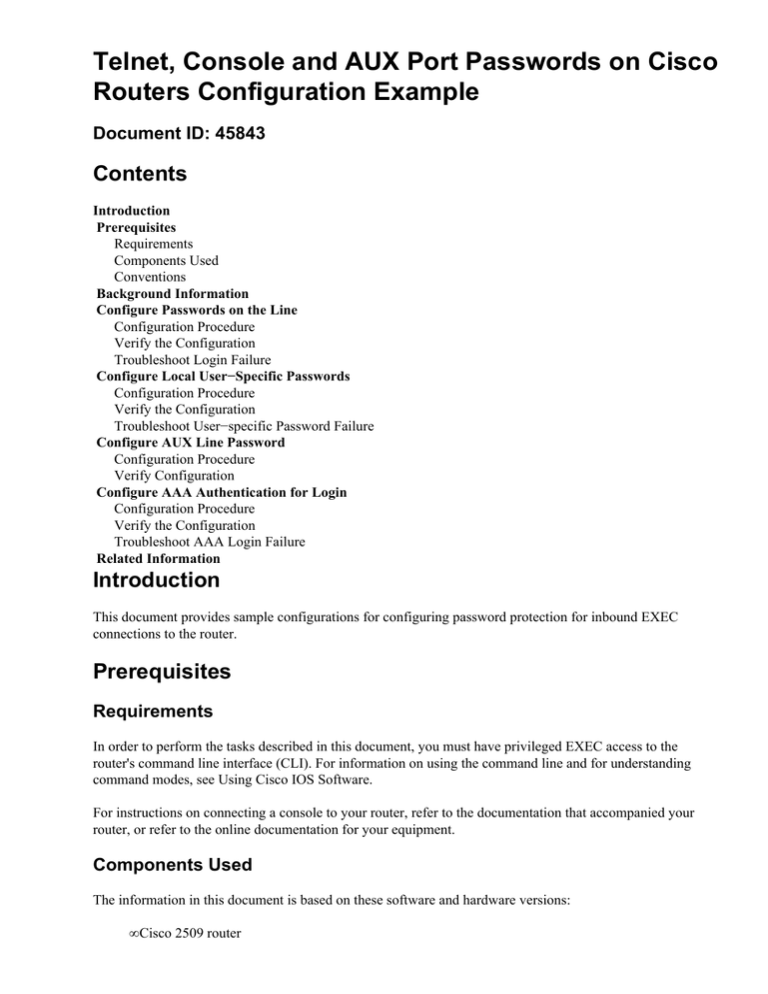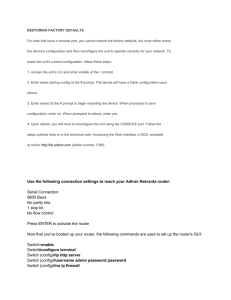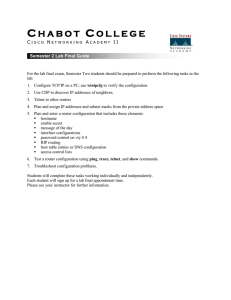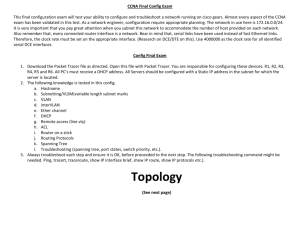
Telnet, Console and AUX Port Passwords on Cisco
Routers Configuration Example
Document ID: 45843
Contents
Introduction
Prerequisites
Requirements
Components Used
Conventions
Background Information
Configure Passwords on the Line
Configuration Procedure
Verify the Configuration
Troubleshoot Login Failure
Configure Local User−Specific Passwords
Configuration Procedure
Verify the Configuration
Troubleshoot User−specific Password Failure
Configure AUX Line Password
Configuration Procedure
Verify Configuration
Configure AAA Authentication for Login
Configuration Procedure
Verify the Configuration
Troubleshoot AAA Login Failure
Related Information
Introduction
This document provides sample configurations for configuring password protection for inbound EXEC
connections to the router.
Prerequisites
Requirements
In order to perform the tasks described in this document, you must have privileged EXEC access to the
router's command line interface (CLI). For information on using the command line and for understanding
command modes, see Using Cisco IOS Software.
For instructions on connecting a console to your router, refer to the documentation that accompanied your
router, or refer to the online documentation for your equipment.
Components Used
The information in this document is based on these software and hardware versions:
• Cisco 2509 router
• Cisco IOS® Software Version 12.2(19)
The information in this document was created from the devices in a specific lab environment. All of the
devices used in this document started with a cleared (default) configuration. If your network is live, make sure
that you understand the potential impact of any command.
Conventions
For more information on document conventions, refer to the Cisco Technical Tips Conventions.
Background Information
The use of password protection to control or restrict access to the command line interface (CLI) of your router
is one of the fundamental elements of an overall security plan.
Protecting the router from unauthorized remote access, typically Telnet, is the most common security that
needs configuring, but protecting the router from unauthorized local access cannot be overlooked.
Note: Password protection is just one of the many steps you should use in an effective in−depth network
security regimen. Firewalls, access−lists, and control of physical access to the equipment are other elements
that must be considered when implementing your security plan.
Command line, or EXEC, access to a router can be made in a number of ways, but in all cases the inbound
connection to the router is made on a TTY line. There are four main types of TTY lines, as seen in this sample
show line output:
2509#show line
Tty Typ
Tx/Rx
*
0 CTY
1 TTY
9600/9600
2 TTY
9600/9600
3 TTY
9600/9600
4 TTY
9600/9600
5 TTY
9600/9600
6 TTY
9600/9600
7 TTY
9600/9600
8 TTY
9600/9600
9 AUX
9600/9600
10 VTY
11 VTY
12 VTY
13 VTY
14 VTY
A Modem
−
−
−
−
−
−
−
−
−
−
−
−
−
−
−
−
−
−
−
−
−
−
−
−
−
−
−
−
−
−
Roty AccO AccI
−
−
−
−
−
−
−
−
−
−
−
−
−
−
−
−
−
−
−
−
−
−
−
−
−
−
−
−
−
−
−
−
−
−
−
−
−
−
−
−
−
−
−
−
−
Uses
0
0
0
0
0
0
0
0
0
0
0
0
0
0
0
Noise
0
0
0
0
0
0
0
0
0
0
0
0
0
0
0
Overruns
0/0
0/0
0/0
0/0
0/0
0/0
0/0
0/0
0/0
0/0
0/0
0/0
0/0
0/0
0/0
Int
−
−
−
−
−
−
−
−
−
−
−
−
−
−
−
2509#
The CTY line−type is the Console Port. On any router, it appears in the router configuration as line con 0 and
in the output of the show line command as cty. The console port is mainly used for local system access using
a console terminal.
The TTY lines are asynchronous lines used for inbound or outbound modem and terminal connections and
can be seen in a router or access server configuration as line x. The specific line numbers are a function of the
hardware built into or installed on the router or access server.
The AUX line is the Auxiliary port, seen in the configuration as line aux 0.
The VTY lines are the Virtual Terminal lines of the router, used solely to control inbound Telnet connections.
They are virtual, in the sense that they are a function of software − there is no hardware associated with them.
They appear in the configuration as line vty 0 4.
Each of these types of lines can be configured with password protection. Lines can be configured to use one
password for all users, or for user−specific passwords. User−specific passwords can be configured locally on
the router, or you can use an authentication server to provide authentication.
There is no prohibition against configuring different lines with different types of password protection. It is, in
fact, common to see routers with a single password for the console and user−specific passwords for other
inbound connections.
Below is an example of router output from the show running−config command:
2509#show running−config
Building configuration...
Current configuration : 655 bytes
!
version 12.2
.
.
.
!−−− Configuration edited for brevity
line
line
line
line
!
end
con 0
1 8
aux 0
vty 0 4
Configure Passwords on the Line
To specify a password on a line, use the password command in line configuration mode. To enable password
checking at login, use the login command in line configuration mode.
Note: To find additional information on the commands used in this document, use the Command Lookup
Tool (registered customers only) .
Configuration Procedure
In this example, a password is configured for all users attempting to use the console.
1. From the privileged EXEC (or "enable") prompt, enter configuration mode and then switch to line
configuration mode using the following commands. Notice that the prompt changes to reflect the
current mode.
router#configure terminal
Enter configuration commands, one per line.
router(config)#line con 0
router(config−line)#
End with CNTL/Z.
2. Configure the password, and enable password checking at login.
router(config−line)#password letmein
router(config−line)#login
3. Exit configuration mode.
router(config−line)#end
router#
%SYS−5−CONFIG_I: Configured from console by console
Note: Do not save configuration changes to line con 0 until your ability to log in has been verified.
Note: Under the line console configuration, login is a required configuration command to enable password
checking at login. Console authentication requires both the password and the login commands to work.
Verify the Configuration
Examine the configuration of the router to verify that the commands have been properly entered:
Certain show commands are supported by the Output Interpreter Tool (registered customers only) , which
allows you to view an analysis of show command output.
• show running−config − displays the current configuration of the router.
router#show running−config
Building configuration...
...
!−−− Lines omitted for brevity
!
line con
password
login
line 1 8
line aux
line vty
!
end
0
letmein
0
0 4
To test the configuration, log off the console and log in again, using the configured password to
access the router:
router#exit
router con0 is now available
Press RETURN to get started.
User Access Verification
Password:
!−−− Password entered here is not displayed by the router
router>
Note: Before performing this test, ensure that you have an alternate connection into the router, such as
Telnet or dial−in, in case there is a problem logging back into the router.
Troubleshoot Login Failure
If you cannot log back into the router and you have not saved the configuration, reloading the router will
eliminate any configuration changes you have made.
If the configuration changes were saved and you cannot login to the router, you will have to perform a
password recovery. See Password Recovery Procedures to find instructions for your particular platform.
Configure Local User−Specific Passwords
To establish a username−based authentication system, use the username command in global configuration
mode. To enable password checking at login, use the login local command in line configuration mode.
Configuration Procedure
In this example, passwords are configured for users attempting to connect to the router on the VTY lines using
Telnet.
1. From the privileged EXEC (or "enable") prompt, enter configuration mode and enter
username/password combinations, one for each user for whom you want to allow access to the router:
router#configure terminal
Enter configuration commands, one per line.
router(config)#
username russ password montecito
router(config)#
username cindy password belgium
router(config)#
username mike password rottweiler
End with CNTL/Z.
2. Switch to line configuration mode, using the following commands. Notice that the prompt changes to
reflect the current mode.
router(config)#line vty 0 4
router(config−line)#
3. Configure password checking at login.
router(config−line)#login local
4. Exit configuration mode.
router(config−line)#end
router#
%SYS−5−CONFIG_I: Configured from console by console
Note: In order to disable auto Telnet when you type a name on the CLI, configure no logging
preferred on the line that is used. While transport preferred none provides the same output, it also
disables auto Telnet for the defined host that are configured with the ip host command. This is unlike
the no logging preferred command, which stops it for undefined hosts and lets it work for the
defined ones.
Verify the Configuration
Examine the configuration of the router to verify that the commands have been properly entered:
• show running−config − displays the current configuration of the router.
router#show running−config
Building configuration...
!
!−−− Lines omitted for brevity
!
username russ password 0 montecito
username cindy password 0 belgium
username mike password 0 rottweiler
!
!−−− Lines omitted for brevity
!
line con 0
line 1 8
line aux 0
line vty 0 4
login local
!
end
To test this configuration, a Telnet connection must be made to the router. This can be done by
connecting from a different host on the network, but you can also test from the router itself by
telnetting to the IP address of any interface on the router that is in an up/up state as seen in the output
of the show interfaces command.
Here is a sample output if the address of interface ethernet 0 were 10.1.1.1:
router#telnet 10.1.1.1
Trying 10.1.1.1 ... Open
User Access Verification
Username: mike
Password:
!−−− Password entered here is not displayed by the router
router
Troubleshoot User−specific Password Failure
Usernames and passwords are case−sensitive. Users attempting to log in with an incorrectly cased username
or password will be rejected.
If users are unable to log into the router with their specific passwords, reconfigure the username and password
on the router.
Configure AUX Line Password
In order to specify a password on the AUX line, issue the password command in line configuration mode. In
order to enable password checking at login, issue the login command in line configuration mode.
Configuration Procedure
In this example, a password is configured for all users attempting to use the AUX port.
1. Issue the show line command in order to verify the line used by the AUX port.
R1#show line
Tty
0
65
66
67
*
Typ
CTY
AUX
VTY
VTY
Tx/Rx
9600/9600
A Modem Roty AccO AccI
−
−
−
−
−
−
−
−
−
−
−
−
−
−
−
−
−
Uses
−
0
−
−
Noise
0
1
0
0
Overruns Int
0
0/0
0/0
0
0/0
0
0/0
2. In this example, the AUX port is on line 65. Issue these commands in order to configure the router
AUX line:
R1# conf t
R1(config)# line 65
R1(config−line)#modem inout
R1(config−line)#speed 115200
R1(config−line)#transport input all
R1(config−line)#flowcontrol hardware
R1(config−line)#login
R1(config−line)#password cisco
R1(config−line)#end
R1#
Verify Configuration
Examine the configuration of the router in order to verify that the commands have been properly entered:
• The show running−config command displays the current configuration of the router:
R1#show running−config
Building configuration...
!
!−−− Lines omitted for brevity.
line aux 0
password cisco
login
modem InOut
transport input all
speed 115200
flowcontrol hardware
!−−− Lines omitted for brevity.
!
end
Configure AAA Authentication for Login
To enable authentication, authorization, and accounting (AAA) authentication for logins, use the login
authentication command in line configuration mode. AAA services must also be configured.
−
−
−
−
Configuration Procedure
In this example, the router is configured to retrieve users' passwords from a TACACS+ server when users
attempt to connect to the router.
Note: Configuring the router to use other types of AAA servers (RADIUS, for example) is similar. See
Configuring Authentication for additional information.
Note: This document does not address configuration of the AAA server itself. Refer to Security Server
Protocols for information on configuring the AAA server.
1. From the privileged EXEC (or "enable") prompt, enter configuration mode and enter the commands
to configure the router to use AAA services for authentication:
configure
router# terminal
Enter configuration commands, one per line. End with CNTL/Z.
router(config)#aaa new−model
router(config)#aaa authentication login my−auth−list tacacs+
router(config)#tacacs−server host 192.168.1.101
router(config)#tacacs−server key letmein
2. Switch to line configuration mode using the following commands. Notice that the prompt changes to
reflect the current mode.
router(config)#line 1 8
router(config−line)#
3. Configure password checking at login.
router(config−line)#login authentication my−auth−list
4. Exit configuration mode.
router(config−line)#end
router#
%SYS−5−CONFIG_I: Configured from console by console
Verify the Configuration
Examine the configuration of the router to verify that the commands have been properly entered:
• show running−config − displays the current configuration of the router.
router#write terminal
Building configuration...
Current configuration:
!
version 12.0
service timestamps debug uptime
service timestamps log uptime
no service password−encryption
!
hostname router
!
aaa new−model
aaa authentication login my−auth−list tacacs+
!
!−−− Lines omitted for brevity
...
!
tacacs−server host 192.168.1.101
tacacs−server key letmein
!
line con 0
line 1 8
login authentication my−auth−list
line aux 0
line vty 0 4
!
end
To test this particular configuration, an inbound or outbound connection must be made to the line. See the
Modem − Router Connection Guide for specific information on configuring async lines for modem
connections.
Alternately, you can configure one or more VTY lines to perform AAA authentication and perform your
testing thereupon.
Troubleshoot AAA Login Failure
Before issuing debug commands, see Important Information on Debug Commands.
To troubleshoot a failed login attempt, use the debug command appropriate to your configuration:
• debug aaa authentication
• debug radius
• debug kerberos
Related Information
• Configuring Authentication
• Cisco IOS Debug Command Reference
• Technical Support − Cisco Systems
Contacts & Feedback | Help | Site Map
© 2014 − 2015 Cisco Systems, Inc. All rights reserved. Terms & Conditions | Privacy Statement | Cookie Policy | Trademarks of
Cisco Systems, Inc.
Updated: Jul 13, 2012
Document ID: 45843





